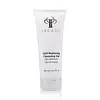What's inside
What's inside
 Key Ingredients
Key Ingredients

No key ingredients
 Benefits
Benefits

 Concerns
Concerns

 Ingredients Side-by-side
Ingredients Side-by-side

Water
Skin ConditioningSodium Methyl Cocoyl Taurate
CleansingGlycerin
HumectantPentylene Glycol
Skin ConditioningCoco-Betaine
CleansingButylene Glycol
HumectantSodium Chloride
MaskingPolygonum Cuspidatum Root Extract
AntioxidantChamomilla Recutita Flower Extract
MaskingRosmarinus Officinalis Leaf Extract
AntimicrobialGlycyrrhiza Glabra Root Extract
BleachingCamellia Sinensis Leaf Extract
AntimicrobialScutellaria Baicalensis Root Extract
AstringentAllantoin
Skin ConditioningSqualane
EmollientAcrylates/C10-30 Alkyl Acrylate Crosspolymer
Emulsion StabilisingPolyquaternium-7
PEG-60 Hydrogenated Castor Oil
EmulsifyingPotassium Hydroxide
BufferingEthylhexylglycerin
Skin ConditioningCitric Acid
BufferingSodium Benzoate
MaskingParfum
MaskingWater, Sodium Methyl Cocoyl Taurate, Glycerin, Pentylene Glycol, Coco-Betaine, Butylene Glycol, Sodium Chloride, Polygonum Cuspidatum Root Extract, Chamomilla Recutita Flower Extract, Rosmarinus Officinalis Leaf Extract, Glycyrrhiza Glabra Root Extract, Camellia Sinensis Leaf Extract, Scutellaria Baicalensis Root Extract, Allantoin, Squalane, Acrylates/C10-30 Alkyl Acrylate Crosspolymer, Polyquaternium-7, PEG-60 Hydrogenated Castor Oil, Potassium Hydroxide, Ethylhexylglycerin, Citric Acid, Sodium Benzoate, Parfum
Water
Skin ConditioningSodium Lauryl Sulfoacetate
CleansingSodium Chloride
MaskingSodium Methyl 2-Sulfolaurate
CleansingPanthenol
Skin ConditioningHydroxypropyl Methylcellulose
Emulsion StabilisingAllantoin
Skin ConditioningDisodium 2-Sulfolaurate
CleansingLaminaria Japonica Extract
Skin ProtectingMalva Sylvestris Leaf Extract
Skin ConditioningPlukenetia Volubilis Seed Extract
Skin ConditioningButylene Glycol
HumectantChlorphenesin
AntimicrobialBenzoic Acid
MaskingSorbic Acid
PreservativeCaprylyl Glycol
EmollientPhenoxyethanol
PreservativeHexylene Glycol
EmulsifyingParfum
MaskingWater, Sodium Lauryl Sulfoacetate, Sodium Chloride, Sodium Methyl 2-Sulfolaurate, Panthenol, Hydroxypropyl Methylcellulose, Allantoin, Disodium 2-Sulfolaurate, Laminaria Japonica Extract, Malva Sylvestris Leaf Extract, Plukenetia Volubilis Seed Extract, Butylene Glycol, Chlorphenesin, Benzoic Acid, Sorbic Acid, Caprylyl Glycol, Phenoxyethanol, Hexylene Glycol, Parfum
 Reviews
Reviews

Ingredients Explained
These ingredients are found in both products.
Ingredients higher up in an ingredient list are typically present in a larger amount.
Allantoin is a soothing ingredient known for its protective and moisturizingg properties. Because of this, it is often added to products with strong active ingredients.
Studies show higher concentrations of this ingredient can promote wound healing.
Though it can be derived from the comfrey plant, allantoin is produced synthetically for cosmetic products to ensure purity.
Learn more about AllantoinButylene Glycol (or BG) is used within cosmetic products for a few different reasons:
Overall, Butylene Glycol is a safe and well-rounded ingredient that works well with other ingredients.
Though this ingredient works well with most skin types, some people with sensitive skin may experience a reaction such as allergic rashes, closed comedones, or itchiness.
Learn more about Butylene GlycolParfum is a catch-all term for an ingredient or more that is used to give a scent to products.
Also called "fragrance", this ingredient can be a blend of hundreds of chemicals or plant oils. This means every product with "fragrance" or "parfum" in the ingredients list is a different mixture.
For instance, Habanolide is a proprietary trade name for a specific aroma chemical. When used as a fragrance ingredient in cosmetics, most aroma chemicals fall under the broad labeling category of “FRAGRANCE” or “PARFUM” according to EU and US regulations.
The term 'parfum' or 'fragrance' is not regulated in many countries. In many cases, it is up to the brand to define this term.
For instance, many brands choose to label themselves as "fragrance-free" because they are not using synthetic fragrances. However, their products may still contain ingredients such as essential oils that are considered a fragrance by INCI standards.
One example is Calendula flower extract. Calendula is an essential oil that still imparts a scent or 'fragrance'.
Depending on the blend, the ingredients in the mixture can cause allergies and sensitivities on the skin. Some ingredients that are known EU allergens include linalool and citronellol.
Parfum can also be used to mask or cover an unpleasant scent.
The bottom line is: not all fragrances/parfum/ingredients are created equally. If you are worried about fragrances, we recommend taking a closer look at an ingredient. And of course, we always recommend speaking with a professional.
Learn more about ParfumChances are, you eat sodium chloride every day. Sodium Chloride is also known as table salt.
This ingredient has many purposes in skincare: thickener, emulsifier, and exfoliator.
You'll most likely find this ingredient in cleansers where it is used to create a gel-like texture. As an emulsifier, it also prevents ingredients from separating.
There is much debate on whether this ingredient is comedogenic. The short answer - comedogenic ratings don't tell the whole story. Learn more about comegodenic ratings here.
The concensus about this ingredient causing acne seems to be divided. Research is needed to understand if this ingredient does cause acne.
Scrubs may use salt as the primary exfoliating ingredient.
Learn more about Sodium ChlorideWater. It's the most common cosmetic ingredient of all. You'll usually see it at the top of ingredient lists, meaning that it makes up the largest part of the product.
So why is it so popular? Water most often acts as a solvent - this means that it helps dissolve other ingredients into the formulation.
You'll also recognize water as that liquid we all need to stay alive. If you see this, drink a glass of water. Stay hydrated!
Learn more about Water